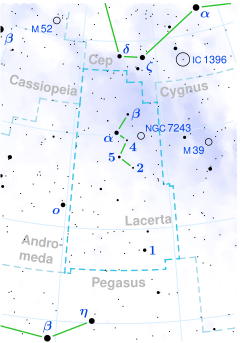V424 Lacertae
| Observation data Epoch J2000.0 Equinox J2000.0 | |
|---|---|
| Constellation | Lacerta |
| Right ascension | 22h 56m 25.99839s[1] |
| Declination | +49° 44′ 00.7587″[1] |
| Apparent magnitude (V) | +4.94[2] |
| Characteristics | |
| Spectral type | K5 Ib[3] |
| U−B color index | +1.95[2] |
| B−V color index | +1.77[2] |
| Variable type | Lc[4] |
| Astrometry | |
| Radial velocity (Rv) | −9.50[5] km/s |
| Proper motion (μ) | RA: −0.649 mas/yr[1] Dec.: −2.768 mas/yr[1] |
| Parallax (π) | 1.4018 ± 0.1129 mas[1] |
| Distance | 2,300 ± 200 ly (710 ± 60 pc) |
| Absolute magnitude (MV) | −4.27[6] |
| Details | |
| Mass | 6.8[7] M☉ |
| Radius | 288+26 −21[8] R☉ |
| Luminosity | 16,600+4,300 −3,400[9] L☉ |
| Surface gravity (log g) | +0.50[7] cgs |
| Temperature | 3749±49[9] K |
| Other designations | |
| Database references | |
| SIMBAD | data |
V424 Lacertae (V424 Lac) is a red supergiant variable star in the constellation Lacerta. It is a member of the Lacerta OB1 stellar association.

The MK spectral type of V424 Lac has been determined to be K5,[3] but it has also been classified as M0.[6] It was discovered to be slightly variable using analysis of Hipparcos photometry. The total range is less than a tenth of a magnitude.[11] Multiple short periods are detected, as well as slow variations with a period of 1,100 or 1,601 days. Although listed in the General Catalogue of Variable Stars as a slow irregular variable, it has been considered to be either a semiregular variable or long secondary period variable.[10]
There is an ultraviolet excess from V424 Lacertae, that may be due to an unseen companion, which could also explain the long secondary period. On this assumption, a sub-stellar companion in a 1,382 day 6.2 AU orbit has been suggested.[7]
References
[edit]- ^ a b c d Vallenari, A.; et al. (Gaia collaboration) (2023). "Gaia Data Release 3. Summary of the content and survey properties". Astronomy and Astrophysics. 674: A1. arXiv:2208.00211. Bibcode:2023A&A...674A...1G. doi:10.1051/0004-6361/202243940. S2CID 244398875. Gaia DR3 record for this source at VizieR.
- ^ a b c Ducati, J. R. (2002). "VizieR Online Data Catalog: Catalogue of Stellar Photometry in Johnson's 11-color system". CDS/ADC Collection of Electronic Catalogues. 2237: 0. Bibcode:2002yCat.2237....0D.
- ^ a b Keenan, Philip C.; McNeil, Raymond C. (1989). "The Perkins catalog of revised MK types for the cooler stars". Astrophysical Journal Supplement Series. 71: 245. Bibcode:1989ApJS...71..245K. doi:10.1086/191373. S2CID 123149047.
- ^ Samus, N. N.; Durlevich, O. V.; et al. (2009). "VizieR Online Data Catalog: General Catalogue of Variable Stars (Samus+ 2007-2013)". VizieR On-line Data Catalog: B/GCVS. Originally Published in: 2009yCat....102025S. 1. Bibcode:2009yCat....102025S.
- ^ Gontcharov, G. A. (2006). "Pulkovo Compilation of Radial Velocities for 35 495 Hipparcos stars in a common system". Astronomy Letters. 32 (11): 759–771. arXiv:1606.08053. Bibcode:2006AstL...32..759G. doi:10.1134/S1063773706110065. S2CID 119231169.
- ^ a b Levesque, Emily M.; Massey, Philip; Olsen, K. A. G.; Plez, Bertrand; Josselin, Eric; Maeder, Andre; Meynet, Georges (2005). "The Effective Temperature Scale of Galactic Red Supergiants: Cool, but Not As Cool As We Thought". The Astrophysical Journal. 628 (2): 973–985. arXiv:astro-ph/0504337. Bibcode:2005ApJ...628..973L. doi:10.1086/430901. S2CID 15109583.
- ^ a b c Lee, B.-C.; Han, I.; Park, M.-G.; Hatzes, A. P.; Kim, K.-M. (2014). "Low-amplitude and long-period radial velocity variations in giants HD 3574, 63 Cygni, and HD 216946". Astronomy & Astrophysics. 566: A124. arXiv:1405.5955. Bibcode:2014A&A...566A.124L. doi:10.1051/0004-6361/201321863. S2CID 54177778.
- ^ Ryan Norris. "Student Science at NMT: Learning Optical Interferometry Through Projects on Evolved Stars" (PDF). CHARA.
- ^ a b Taniguchi, Daisuke; Matsunaga, Noriyuki; Jian, Mingjie; Kobayashi, Naoto; Fukue, Kei; Hamano, Satoshi; Ikeda, Yuji; Kawakita, Hideyo; Kondo, Sohei; Otsubo, Shogo; Sameshima, Hiroaki; Takenaka, Keiichi; Yasui, Chikako (2022-05-01). "Erratum: Effective temperatures of red supergiants estimated from line-depth ratios of iron lines in the YJ bands, 0.97-1.32 μm". Monthly Notices of the Royal Astronomical Society. 512 (2): 2669–2670. Bibcode:2022MNRAS.512.2669T. doi:10.1093/mnras/stac686. ISSN 0035-8711.
- ^ a b Messina, Sergio (2007). "Evidence for the pulsational origin of the Long Secondary Periods: The red supergiant star V424 Lac (HD 216946)". New Astronomy. 12 (7): 556–561. Bibcode:2007NewA...12..556M. doi:10.1016/j.newast.2007.04.002.
- ^ Kazarovets, E. V.; Samus, N. N.; Durlevich, O. V.; Frolov, M. S.; Antipin, S. V.; Kireeva, N. N.; Pastukhova, E. N. (1999). "The 74th Special Name-list of Variable Stars". Information Bulletin on Variable Stars. 4659: 1. Bibcode:1999IBVS.4659....1K.

